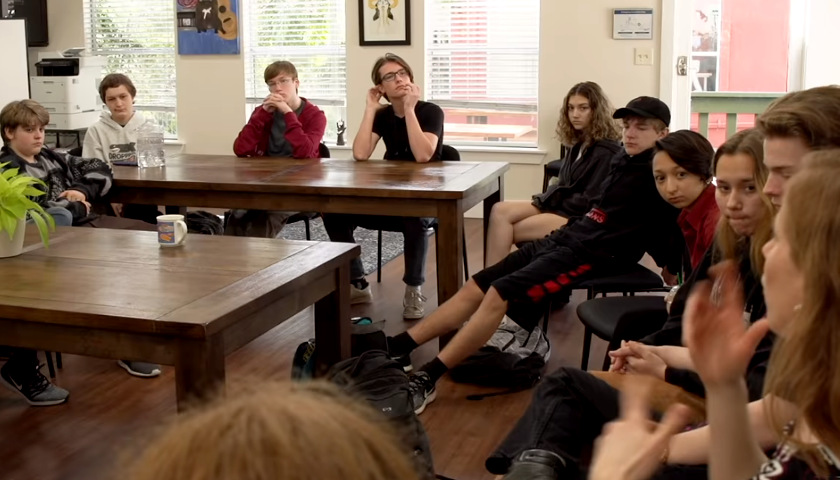by Annie Holmquist
By now, many parents know there is something seriously wrong with the average American school. Time and again, children go into the school system as bright bundles of energy, curious about the surrounding world, and time and again, they stagger through the system frustrated and losing their interest in learning. Unfortunately, parents have firsthand knowledge of what former New York teacher John Taylor Gatto explained in his book, Weapons of Mass Instruction:
“After a long life, and thirty years in the public school trenches, I’ve concluded that genius is as common as dirt. We suppress genius because we haven’t yet figured out how to manage a population of educated men and women. The solution, I think, is simple and glorious. Let them manage themselves.”
That’s easy enough to say, but is it actually possible to do?
A video from Reason suggests that it is possible, and in fact, is actually being done quite effectively. Host John Stossel travels to the Academy of Thought and Industry (ATI) to explore a school filled with kids who would likely be considered dysfunctional and troublemakers in the normal education system. Instead, Stossel finds a group of thriving young adults, thinking intelligently and actively entering the real world as enterprising individuals.
School founder Michael Strong explains the educational philosophy of ATI:
“I want my students to think with their minds and understand the world. I want them to get stuff done.” He goes on to say, “Teens need responsibility. Ben Franklin, Andrew Carnegie, Thomas Edison started their careers at the age of 12 or 13. I worked as a teen. I loved it!”
Strong developed the idea of a challenging, hands-on learning experience partly through his own negative encounter with the education system. He notes, “School is 13 years of how to be passive and how to be dependent.”
The Academy of Thought and Industry turns this concept on its head:
School is about aim, aim, aim, aim and NEVER get stuff done. So I want students who – let’s just go out there and get stuff done, fail, get up, try again. That’s how we become creators, entrepreneurs. We want them to do what they love now.
At first blush, the Academy of Thought and Industry seems like one of those trendy educational ideas that allow students to learn for themselves without any real structure or direction. But digging into the school’s website, one discovers this is not the case. Of particular interest is the school’s approach to reading, thinking, and discussion.
Every morning begins with a Socratic dialogue in which students presumably debate and discuss the ideas they have read in assigned texts. These texts apparently aren’t a walk in the park, either, as one photo from the site pictures students reading Dante. According to an article on the ATI website, the school believes in challenging its students with high-level texts in order to prepare them interaction with the deep ideas of the world. The reason is simple:
If students read, think about, and learn how to understand very sophisticated and complex texts, in addition to the obvious benefits of simply building these skills for the sake of being a more discerning reader and writer, they will do well on … [the critical reading and writing] portion of the SAT exam. Unfortunately, most students rarely encounter adequately sophisticated prose. The average high school senior tends to choose material at the 7th grade level when they choose to read. At the same time, high school textbooks have continued to simplify the reading level such that high school seniors will often be studying history written at a 9th or 10th grade reading level. Finally, even those students who do work with a few challenging texts for an AP Literature class, for example, are often rushing to get through the prose (or even using Cliff’s Notes).
Slow, careful, analytical reading of demanding texts over the course of years, with a focus on understanding the precise meaning of texts, is one of the most powerful ways to develop the sophisticated reading skills that are reflected by high SAT scores. Very few students even encounter a course that requires this over their four years of high school.
Is such a philosophy working? The evidence suggests yes, for students at ATI schools who have experienced this schooling have almost a 30-point lead over their peers in other schools on the SAT Evidence-Based Reading and Writing exam.
Perhaps it’s time for more of American schools to rise to the challenge and stop trying to place students in the soul-crushing box of conformity and mediocrity?
– – –
Annie Holmquist is a senior writer for Intellectual Takeout. In her role, she assists with website content production and social media messaging. Annie received a B.A. in Biblical Studies from the University of Northwestern-St. Paul. She also brings 20+ years of experience as a music educator and a volunteer teacher – particularly with inner city children – to the table in her research and writing. In her spare time Annie enjoys the outdoors, gardening, reading, and events with family and friends.





